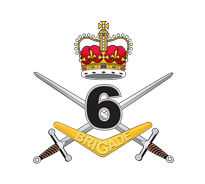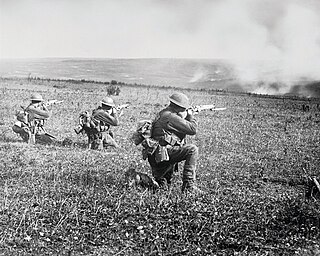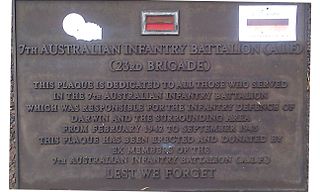
The First Australian Army was a field army of the Australian Army, during World War II. The formation's headquarters was raised in April 1942 from the existing 1st Australian Corps headquarters, assuming command of all Allied troops in Queensland. Initially, the formation was assigned a defensive role in anticipation of a possible Japanese invasion; however, this threat subsided and eventually the army was deployed to Lae, in New Guinea, in late 1944, where it co-ordinated Australian offensives around Aitape, in New Guinea, on New Britain and Bougainville, and around Madang. The formation was disbanded in February 1946, when it was redesignated as the 8th Military District.

III Corps was an Australian Army unit during World War II. It was responsible for the defence of Western Australia in 1942–1944. The corps was formed in April 1942 from Western Command, which had been established in October 1939. Throughout the war, the formation's size expanded and contracted as available manpower, and the strategic situation, dictated. At its height, the corps consisted of two infantry divisions and one armoured division, which were deployed to defend against a Japanese invasion threat, which ultimately never eventuated. The corps ceased to exist in June 1944 when it was converted back into Western Command, which remained until the end of the war in 1945.

The 2nd Armoured Division was an armoured formation of the Australian Army during World War II. Originally raised in 1921 as the 2nd Cavalry Division, based in Victoria and South Australia, the formation had been converted into a motor division in early 1942, before adopting the armoured designation later in the year. A Militia formation, the division undertook garrison duties in Australia and did not see combat before being disbanded in mid-1943.

The 3rd Brigade is a combined arms brigade of the Australian Army, principally made up of the 1st and 3rd Battalions of the Royal Australian Regiment. Initially raised in 1903 as part of the post-Federation Australian Army, it was removed from the order of battle in 1906 following the restructure of the field force. It was re-formed in 1914 for service during World War I, taking part in the fighting at Gallipoli and on the Western Front in Europe. During World War II the brigade was used in a defensive role before it was disbanded in 1944. It was re-raised in 1967 for service during the Vietnam War and later went on to provide the nucleus of the deployment to East Timor during the Australian-led intervention in 1999. The brigade is currently based at Lavarack Barracks in Townsville, Queensland.

The 16th Brigade was an infantry brigade in the Australian Army. First raised in 1912 as a Militia formation to provide training under the compulsory training scheme, the brigade was later re-raised as part of the First Australian Imperial Force during World War I. Its existence was short-lived, as it was disbanded after about six months, before it could be committed to the fighting on the Western Front. Raised again in 1939 for service during World War II, the brigade was deployed to the Middle East in early 1940 and subsequently saw action in the Western Desert and in Greece in 1941. In 1942, it returned to Australia in response to Japan's entry into the war, and later the brigade played a prominent role in the Kokoda Track campaign and at Buna–Gona in Papua. Withdrawn to Australia in early 1943, the 16th Brigade was re-organised and received many replacements from disbanding formations, but it was not recommitted to combat operations until late in the war. In 1944–1945, the brigade was committed to the Aitape–Wewak campaign in New Guinea. After the war, the brigade was disbanded in 1946. Today, its name is perpetuated by the 16th Aviation Brigade which was raised on 2 April 2002.

I Corps was an Australian Army corps, one of three that were raised by the Army during World War II. It was the main Australian operational corps for much of the war. Various Australian and other Allied divisions came under its control at different times. In 1940–1942, the corps was based in the Mediterranean and Middle Eastern theatres, and controlled forces in action against the Germans, Italians and later the Vichy French in North Africa, Greece and Syria–Lebanon.

II Corps was an Australian Army corps, one of three that were raised by the Army during the Second World War. Formed in mid-1942 as part of defensive measures to protect the eastern coast of Australia from invasion, the corps was initially composed mainly of home defence troops drawn from the Militia. For a brief period in 1942, a US infantry division was also assigned to the corps prior to its dispatch to fight the Japanese in New Guinea.

The 2/4th Armoured Regiment was an armoured regiment of the Australian Army, which served during World War II. The regiment was formed in November 1942 as part of the Second Australian Imperial Force by amalgamating a number of previously existing armoured units and was disbanded in September 1946 after seeing action in New Guinea and Bougainville Island, where it provided individual squadron-group sized elements which operated in support of infantry operations against the Japanese. During its service the regiment received 10 battle honours.

The 2/12th Field Ambulance was an Australian military unit of the Second Australian Imperial Force, serving during World War II. During their six years of service, over 200 soldiers were killed, the highest figure for a non-combatant unit in Australian history. The majority of the unit's casualties were suffered during the sinking of the hospital ship Centaur in May 1943. During the war, the 2/12th deployed personnel in support of Australian combat operations against the Japanese on Ambon, Timor and in Borneo before being disbanded in 1946.

The 11th Brigade is an Australian Army brigade which currently comprises most Australian Army Reserve units located in Queensland. The brigade was first formed in early 1912 following the introduction of the compulsory training scheme. Later, as part of the 3rd Division and saw action during World War I on the Western Front as part of the First Australian Imperial Force. In the interwar years, the brigade was re-raised with its headquarters in Brisbane.

The 6th Combat Support Brigade is an Australian Army brigade. First formed in 1912 as a Militia formation to provide training under the compulsory training scheme, the brigade was re-raised during the First World War as an infantry unit of the all volunteer Australian Imperial Force. It subsequently served at Gallipoli and in France and Belgium on the Western Front. In the 1920s, as part of a reorganisation of the Australian Army, it became part of the 3rd Military District of the Citizens Military Force, encompassing units from Victoria and South Australia. In 1991, it became part of the Ready Reserve Scheme, based at Enoggera Barracks, in Brisbane, Queensland, before being disbanded in 1996 when the scheme was discontinued. The brigade was re-raised on 1 March 2010 to oversee the Army's command support and intelligence, surveillance, target acquisition and reconnaissance units.

The 2nd Health Brigade (2HB) is an Australian Army brigade. The 2nd Brigade was formed in 1903 as a militia infantry formation based in Victoria, the brigade later served during the First World War as part of the Australian Imperial Force, allocated to the 1st Division. During the war, the 2nd Brigade took part in the fighting at Gallipoli, including the Battle of Krithia where it lost almost a third of its strength. Later they took part in the Battle of Lone Pine before being withdrawn back to Egypt in December 1915. Following this the brigade was transferred to the Western Front in France and Belgium where, between March 1916 and the armistice in November 1918, they took part in most of the major Allied operations.

The 1st Armoured Brigade was a formation of the Australian Army during World War II. The brigade was formed in July 1941, at Greta, New South Wales from volunteers for the Second Australian Imperial Force and was assigned to the 1st Armoured Division. Raised initially for service in the Middle East, following Japan's entry into the war, the brigade was assigned to the defence of Australia in case of an invasion. After garrison duties in New South Wales and Western Australia, it was disbanded in November 1944 without seeing active service, although some of its former units saw action later with other formations.

The 2nd Armoured Brigade was a formation of the Australian Army during World War II. The brigade was formed in July 1941, at Puckapunyal, Victoria, from Second Australian Imperial Force volunteers. It was assigned to the 1st Armoured Division in July 1941, with the intention of deploying it to the Middle East. However, it was reassigned to home defence following Japan's entry into the war, and was then transferred to the 3rd Armoured Division in October 1942. The brigade remained in Australia, undertaking defensive duties in Victoria and Queensland before being disbanded in January 1944. While it did not see any active service as a formation, some of its constituent units eventually took part in the campaigns on Tarakan, Labuan, Bougainville and around Aitape–Wewak in 1944–1945 after transferring to other brigades.
The 3rd Motor Brigade was a formation of the Australian Army during the interwar years and early part of World War II. Initially raised in 1921 as the 3rd Cavalry Brigade in Victoria, it was a formation of the part-time Militia. It consisted of three light horse regiments, which were spread across several depots in regional Victoria. During World War II, the brigade was mobilised for defensive duties in December 1941 to defend against a possible invasion. In early 1942, it was converted into a motorised formation and was redesignated as the 3rd Motor Brigade. The brigade moved to Western Australia in late 1942 and remained there until August 1944 when it was disbanded without having seen combat.

The 12th Brigade was an infantry brigade of the Australian Army. Formed in 1912 as a Militia formation, it was later re-raised in 1916 as part of the all volunteer First Australian Imperial Force that was raised for overseas service during the First World War. The brigade was part of the 4th Division and fought on the Western Front until the end of the war in November 1918. During the inter-war years, the brigade was re-formed in Australia as a part-time unit; during the Second World War, it was mobilised for full-time service, but did not serve overseas, undertaking garrison duties in Australia until 1945 when it was used to raise Timor Force.

The 23rd Brigade was a brigade of the Australian Army. It was briefly raised in 1912 as a Militia formation providing training as part of the compulsory training scheme. Later, it was re-formed in July 1940 for service during the Second World War, the brigade was initially a formation of the Second Australian Imperial Force assigned to the 8th Division; however, after its sub units were captured by the Japanese in 1942 it was reformed with Militia battalions and was mainly used in a garrison role around Darwin, in the Northern Territory, until late in the war when it was committed to the fighting against the Japanese on Bougainville. It was disbanded in 1946.

The 19th Brigade was a formation of the Australian Army that was raised as part of the Second Australian Imperial Force for service during World War II. It was briefly raised in 1912 as a Militia formation providing training as part of the compulsory training scheme. Later, during World War II, the brigade was established in April 1940 in Palestine as a triangular formation, the brigade was created by transferring one infantry battalion from three other brigades. It was subsequently assigned to the 6th Division. Throughout 1941, the brigade fought in North Africa, Greece and on Crete, before undertaking garrison duties in Syria, remaining there until January 1942. Following the Japanese entry into the war, the 19th Brigade was withdrawn to Australia and subsequently undertook garrison duties in Darwin. It did not see combat again until late in the war, when it was committed to the Aitape–Wewak campaign in 1944–1945. The brigade was disbanded in December 1945 in Puckapunyal.

The 20th Brigade was a brigade-sized infantry unit of the Australian Army. First raised in 1912 as a Militia formation to provide training under the compulsory training scheme, the brigade was later re-raised on 7 May 1940 as part of the all volunteer Second Australian Imperial Force for service during the World War II. The brigade was initially assigned to the 7th Division, but was later transferred to the 9th Division in early 1941. They subsequently took part in the Siege of Tobruk that year, and then the First and Second Battles of El Alamein in 1942. In early 1943, the brigade was returned to Australia to join the fighting against the Japanese in the Pacific. In late 1943, the brigade took part in the capture of Lae and then the Huon Peninsula campaign. Withdrawn to Australia in early 1944, its final campaign came during the Battle of North Borneo in the final months of the war. It was disbanded in February 1946.

The structure of the Australian Army changed considerably during World War II. At the outbreak of war the Army comprised a small regular component and a large, but ill-trained and equipped, militia force. In September 1939 the government authorised the establishment of the Second Australian Imperial Force for overseas service; this force eventually reached a strength of four infantry divisions, an armoured division and various headquarters and support units. The militia force, which remained in Australia, was neglected until the outbreak of the Pacific War.




















